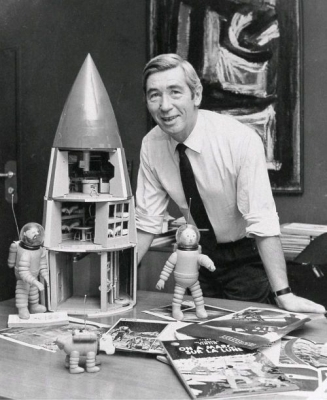
The intrepid boy reporter from Belgium took the world by storm when he made his debut on January 10, 1929. “The Adventures of Tintin”, a comic strip created by Georges Prosper Remi, better known as Herge, appeared in a serialised format in Le Petit Vingtième. The strip ran until May 8, 1930.
But not even Tintin himself could have predicted its runaway success.
The Belgian comic strip was translated to as many as 70 languages and adapted to television, radio and film. It has sold 20 million copies across the world.
While Tintin turned 92, his friend Captain Archibald Haddock turned 80. From the Soviet Union to China, Tintin has travelled the world in search of mysteries and adventures. Read on to know more about this iconic character and its creator…
Early life
Remi loved to draw and was constantly sketching out scenes from daily life along the edges of his school books. Some of these illustrations were of German soldiers, because his four years of primary schooling at the Ixelles Municipal School No. 3 coincided with World War I, during which Brussels was occupied by the German army.
From Totor to Tintin
Herge created his first comic strip “Les Aventures de Adventures of Totor’) for the newsletter. The strip revolved around the adventures of a Boy Scout patrol leader. Herge who initially wrote captions underneath the panels, gradually conveyed his ideas through speech bubbles.
After finishing school, Herge enrolled in an art school Ecole Saint-Luc, hoping that it would help him pursue a career in comics. But he found the first lesson so boring that he quit the next day and started looking for a job. But no one wanted to hire him as a comic artist. So he ended up getting a job in the subscription department of a newspaper. But this job couldn’t hold his attention for long. He quit and enlisted for military service. Through his numerous postings, Herge continued sketching and producing episodes of Totor.
The birth of Tintin
Finally at the end of his military service, Herge got a chance to work as a cartoonist and photographic reporter for Le Vingtieme Siecle.
Eager to come up with his own comic strip, Herge developed a character named Tintin as a Belgian boy reporter who could travel the world with his fox terrier, Snowy. The character was largely based on his earlier character of Totor. Herge wanted the character to be based in the U.S., but Wallez persuaded him to set his adventure in the Soviet Union. The result, “Tintin in the Land of the Soviets”, began serialisation in Le Petit Vingtième, a children’s supplement of the paper on January 10,1929, and ran until May 8, 1930. Owing to its popularity in Belgium, the strip came to be published in book form. And with the publication of “Tintin in Congo” and “Tintin in America”, the comic strip soon became an international bestseller.
Captain Haddock turns 80
Tintin’s friend, Captain Haddock completed 80 years in January. The grumpy sailor with a big heart met Tintin in 1941. Haddock made his debut when the strip was published in black and white in the Belgian newspaper Le Soir. On January 9, 1941, in the middle of the World War II, the sailor joined Tintin in a cartoon for the first time.
OH, REALLY?
- A rejected Tintin cover of “Le Lotus Bleu” (‘The Blue Lotus”) illustrated by Herge set a new world record on January 14 as the most expensive comic book artwork. It sold at an auction for £2.8m. The artwork was rejected as too expensive to reproduce in 1936 and given to editors son, who kept it in a drawer for decades.
- Tintin landed on the moon at least 15 years before Neil Armstrong. In 1954, “Tintin On The Moon” was published. It showed Tintin exploring the moon.
- Remi started signing his illustrations as Herge, the phonetic transcription of his initials, RG, in 1924. Tintin’s face has been drawn without much detail. It’s mostly expressionless.
- In memory of the cartoonist, the Herge Museum was established in Louvain-la-Neuve in 2009.
- Herge never actually visited any of the countries which he let Tintin famously explore
Picture Credit : Google




